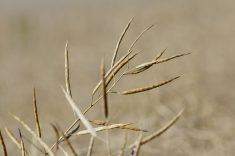Canola crops in northeastern Saskatchewan and east-central Alberta have run up against a potential pest problem so new it doesn’t yet have a name.
Researchers with Agriculture and Agri-Food Canada, the University of Guelph and the Canadian Food Inspection Agency have reported a new species of midge damaging canola crops in those areas.
The species “has yet to be named and scientifically described,” the scientists reported Monday on Alberta’s provincial Insect Pest Monitoring Network website.
The only confirmed symptom of damage so far from the anonymous midge is in the form of “bottle”-shaped galled flowers caused by larval feeding inside flowers, which then won’t produce pods or seeds, the researchers said.
Read Also

New opportunities for Canadian goods in Mexico
Agriculture minister’s trip to Mexico sees promotion of Canadian goods like beef and canola, with potential for more partnerships in the future
Midge damage in Saskatchewan last summer “appeared to be low” in most fields, the researchers said, but the new midge’s full economic impact isn’t yet known. Swede midge in recent years were believed to be damaging Saskatchewan crops around Nipawin and Carrot River.
In Alberta, meanwhile, midge and suspected midge damage were detected last year from the Saskatchewan border around Lloydminister, westward to around Stettler and Smoky Lake.
Work is now underway to formally describe and name the new species, which the researchers said appears similar to Contarinia nasturtii, better known to growers in Eastern Canada as swede midge.
In Ontario, swede midge has been a known plant pest in brassica crops, such as cruciferous vegetables and canola, since 2000. It’s now “widely distributed” in both Ontario and Quebec and has also been seen in Nova Scotia and at least five U.S. states.
Crop scouts for years have noted differences between the Ontario pest and the Saskatchewan midge, researchers said, noting the type and amount of damage caused, the adult midge size and the number of generations per year.
Biologist and chemical ecologist Dr. Boyd Mori of AAFC’s Saskatoon Research and Development Centre also noted “extremely low” capture rates of adult swede midge in pheromone traps despite the “apparently high” rates of adult swede midge emergence.
With that in mind, Mori then collected adult midges and sent them to Guelph for study, where Dr. Rebecca Hallett and James Heal “immediately” noticed differences between the Saskatchewan and Ontario midge.
The Saskatchewan midge, the researchers said, “were more robust, had hairier wings and had slight differences in the antennae and genitalia” compared to the Ontario midge, they observed. Dr. Bradley Sinclair, CFIA’s midge expert in Ottawa, confirmed those differences and others.
Those differences, and DNA sequencing, have led to the conclusion that the Saskatchewan pest is a separate midge species, the researchers said. — AGCanada.com Network












